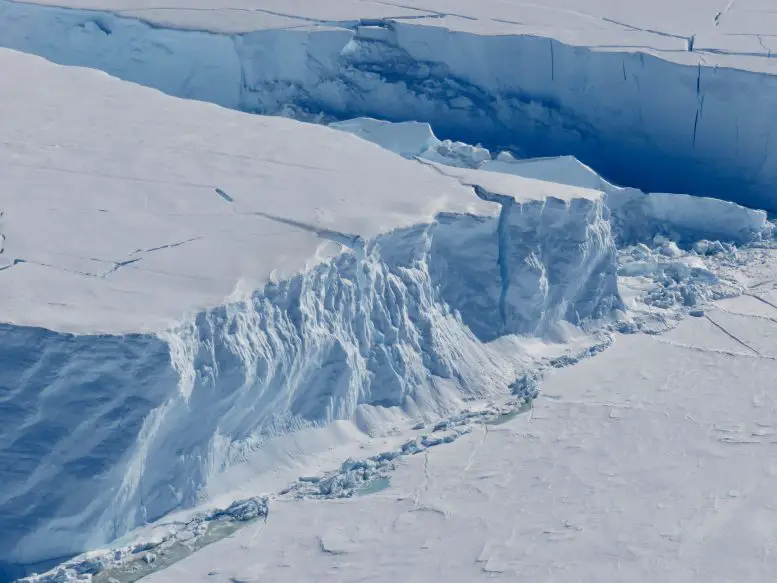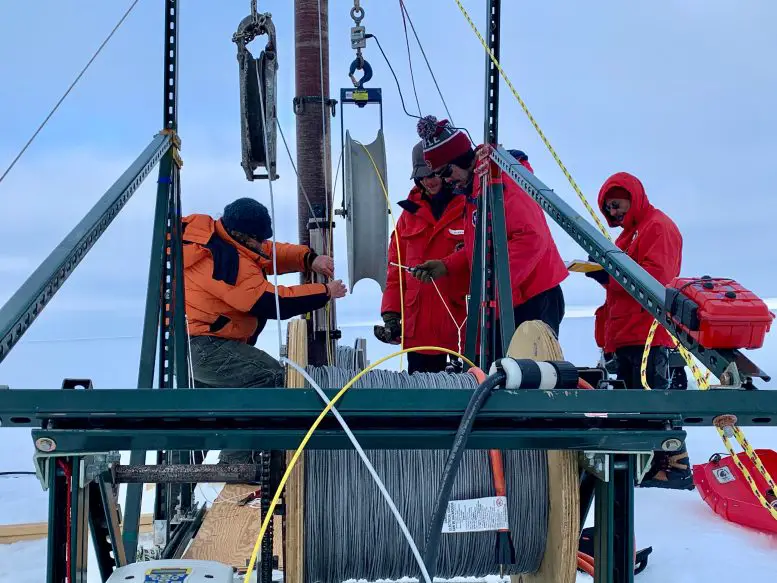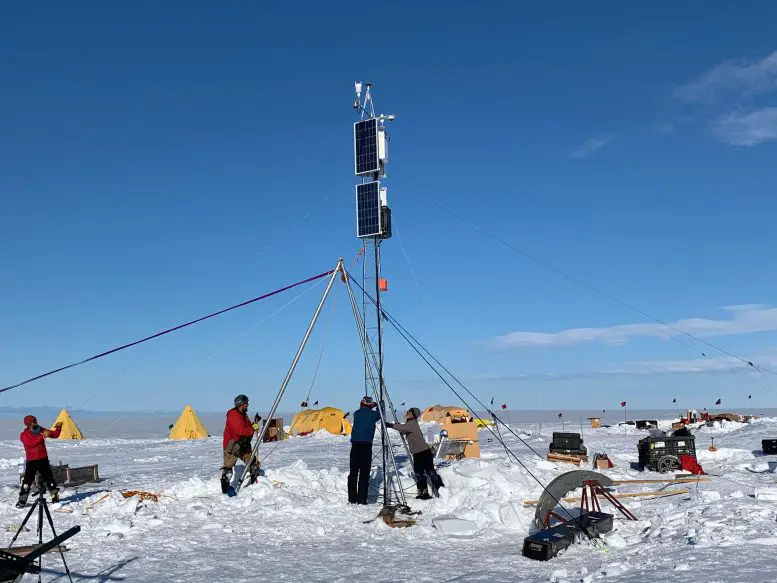An international team of researchers has discovered that adjacent ice shelves play a role in causing instability in others downstream.
The University of East Anglia in the UK led a study that identified that the amount of glacial-meltwater flowing beneath the Thwaites Ice Shelf can be impacted by a small ocean gyre next to it. A weaker gyre allows more warm water to access the areas beneath the ice shelf, causing it to melt.
The Thwaites Ice Shelf is one of the biggest ice shelves in West Antarctica and buttresses the eastern side of the Thwaites Glacier, which has been retreating rapidly over the last 20 years and is the largest contributor to global sea-level rise among Antarctic glaciers.

The Thwaites Ice Shelf in Antarctica. Credit: Karen Alley
Using a unique dataset collected by sensors installed beneath the Thwaites Ice Shelf – which has also thinned and weakened significantly in recent decades – the researchers observed that the shallow layers of the ocean underneath it warmed considerably during the period from January 2020 to March 2021.
Most of this warming was driven by waters with a high volume of glacial meltwater originating from the Pine Island Ice Shelf, further east, flowing into the area beneath the Thwaites Ice Shelf.

Researchers drill boreholes into the Thwaites Ice Shelf to install monitoring sensors underneath. Credit: Karen Alley
The glacial meltwater mixes with saltwater when the ocean melts the base of ice shelves and can form a buoyant layer of water that is warmer than the surrounding waters. This lighter, relatively fresher, and warmer water brings heat that melts the base of the Thwaites Ice Shelf.
Lead author Dr. Tiago Dotto, of the Centre for Ocean and Atmospheric Sciences at UEA, said: “We have identified another process that could impact the stability of ice shelves, revealing the importance of local ocean circulation and sea ice. Circumpolar Deep Water, a warm variety of Antarctic waters, is a key player in melting the base of ice shelves. However, in this study, we show that a great amount of heat at shallow layers beneath one ice shelf can be provided by waters originating from other melting ice shelves nearby. Therefore, what happens to one ice shelf, can impact the adjacent ice shelf, and so on. This process is important for regions of high ice shelf melting such as the Amundsen Sea because one ice shelf sits next to the other, and the export of heat from one ice shelf can reach the next one through the ocean circulation.”
Dr. Dotto added: “These atmosphere-sea-ice-ocean interactions are important because they can prolong warm periods beneath ice shelves by allowing warm and meltwater-enriched water to enter adjacent ice-shelf cavities. Gyres potentially existing in other regions around Antarctica may also cause a greater number of ice shelves to be prone to intense basal melting associated with prolonged warm conditions, and as a result, further contribute to global sea-level rise.”

Researchers erecting a monitoring tower with atmospheric sensors on the Thwaites Ice Shelf. Credit: Karen Alley
In January 2020 colleagues from the US drilled holes in the ice and installed sensors monitoring temperature, salinity, and ocean current beneath the Thwaites Ice Shelf.
For more than a year these sensors sent, via satellite, the data used to identify the ocean variations, for example how the temperature and meltwater content varied. From these observations, the researchers suspected that the excess of heat could not have originated locally at the Thwaites Ice Shelf because they did not see strong melting at the sites where the sensors were installed.
By combining the information with computer simulations to identify the origin of this heat, they found that the water that leaves the Pine Island Ice Shelf can access the areas beneath Thwaites Ice Shelf.
The mechanism that explains how these waters access the Thwaites Ice Shelf was identified by using model simulations and data collected by tags attached to seals. They both showed that a gyre near the Thwaites Ice Shelf weakens in winter, which allows more heat to reach shallow areas beneath the ice shelf.
Satellite images also showed that the Southern Hemisphere summer season of 2020/2021 was unusual because it had a high concentration of sea ice in regions near the Thwaites Ice Shelf.
Drawing on the simulations and previous research, the team hypothesized that the gyre was even weaker, so the excess of meltwater from adjacent ice shelves could not be moved away from that region by the currents and instead entered the Thwaites Ice Shelf.
This reduced, even more, the strength of this gyre, which enabled the inflow of water with a higher concentration of glacial meltwater beneath the ice shelf.
Reference: “Ocean variability beneath Thwaites Eastern Ice Shelf driven by the Pine Island Bay Gyre strength” by Tiago S. Dotto, Karen J. Heywood, Rob A. Hall, Ted A. Scambos, Yixi Zheng, Yoshihiro Nakayama, Shuntaro Hyogo, Tasha Snow, Anna K. Wahlin, Christian Wild, Martin Truffer, Atsuhiro Muto, Karen E. Alley, Lars Boehme, Guilherme A. Bortolotto, Scott W. Tyler and Erin Pettit, 21 December 2022, Nature Communications.
DOI: 10.1038/s41467-022-35499-5
Funding for the Automated Meteorology-Ice-Geophysics-Ocean System (AMIGOS), which collected the data, was received from the National Science Foundation in the US. The research was also supported by the UK Natural Environment Research Council (NERC).



